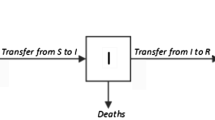Abstract
Pulse vaccination is an effective and important strategy to eradicate an infectious disease. The authors investigate an SEIRS epidemic model with two delays and pulse vaccination. By using the discrete dynamical system determined by stroboscopic map, the authors obtain that the infectious population dies out if R Δ < 1, and the infectious population is uniformly persistent if R Δ > 1. The results indicate that a short period of pulse vaccination or a large pulse vaccination rate is a sufficient condition to eradicate the disease.
Similar content being viewed by others
References
Z. Agur, L. Cojocaru, G. Mazor, R. Anderson, and Y. Danon, Pulse mass measles vaccination across age cohorts, in Pro. Natl. Acad. Sci. USA, 1993, 90(4): 11698–11702.
F. N. M. Al-Showaikh and E. H. Twizell, One-dimensional measles dynamics, Appl. Math. Comput., 2005, 152(1): 169–194.
R. M. Anderson and R. M. May, Population biology of infectious diseases I, Nature, 1979, 180(5721): 361–367.
K. L. Cooke and P. van Den Driessche, Analysis of an SEIRS epidemic model with two delays, J. Math. Biol., 1996, 35(2): 240–260.
E. Beretta and Y. Takeuchi, Global stability of an SIR epidemic mode1 with time delays, J. Math. Biol., 1995, 33(3): 250–260.
E. Beretta and Y. Takeuchi, Convergence results in SIR epidemic mode1 with varying population sizes, Nonlinear Analysis, 1997, 28(12): 1909–1921.
Y. Takeuchi, W. Ma, and E. Beretta, Global asymptotic properties of a delay SIR epidemic model with finite incubation times, Nonlinear Analysis, 2000, 42(6): 931–947.
X. Y. Song and L. S. Chen, Optimal harvesting and stability for a two-species competitive system with stage structure, Math. Biosci., 2001, 170(2): 173–186.
M. C. Schuette, A qualitative analysis of a model for the transmission of varicella-zoster virus, Math. Biosci., 2003, 182(2): 113–126.
D. D. Bainov and P. S. Simeonov, Impulsive Differential Equations: Periodic Solutions and Applications, Longman Scientific and Technical, New York, 1993.
V. Lakshmikantham, D. D. Bainov, and P. S. Simeonov, Theory of Impulsive Differential Equations, World Scientific, Singapore, 1989.
Author information
Authors and Affiliations
Corresponding author
Additional information
*This research was Supported by the National Natural Science Foundation of China under Grant No. 10471117 and the Emphasis Subject of Guizhou College of Finance & Economics.
Rights and permissions
About this article
Cite this article
JIAO, J., CHEN, L. & CAI, S. An SEIRS epidemic model with two delays and pulse vaccination*. J Syst Sci Complex 21, 217–225 (2008). https://doi.org/10.1007/s11424-008-9105-y
Received:
Revised:
Published:
Issue Date:
DOI: https://doi.org/10.1007/s11424-008-9105-y




